MESOPOTAMIA
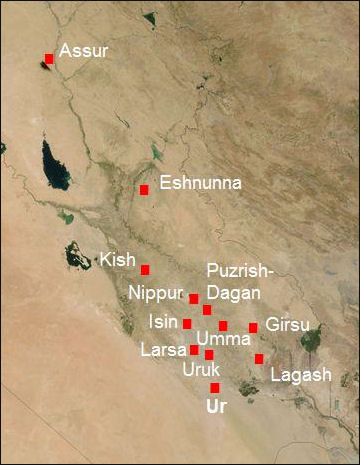
Sumerian periodWidely regarded as the “cradle of civilization,"Mesopotamia was not only the source of Mediterranean and Middle East civilization but was the foundational for much of Western civilization and a great deal of Eastern civilization too. Mesopotamia is the name Greeks gave the region. Locals called it Sumer, Akkad, Babylonia and Assyria depending on the age they lived in and the area they were talking about.
Deborah Solomon wrote in the New York Times, “The ancient kingdom of Mesopotamia, which flourished in the region that became Iraq, is what textbooks like to call the birthplace of urban civilization. The Mesopotamians were the first to record their thoughts in writing, the first to divide the day into 24 hours, the first to eat off ceramic plates. Iraq is home to some of the most important landmarks of the Judeo-Christian tradition, including the reputed Garden of Eden and Ur, the birthplace of the patriarch Abraham. The area had a second flowering in the Middle Ages, when it became a capital of the Islamic world and mosques sprang up everywhere. With war in Iraq looming, many in the art historical world are worried about what might be damaged or destroyed. Below, a map of some of the country's most significant sites. [Source: Deborah Solomon, New York Times, January 05, 2003]
Although ancient 9,500-year old towns and fortified cities have been discovered, Mesopotamia is often considered to be the oldest civilization in the world because of its size, organization and its contributions to world culture. It was founded in present-day Iraq, Turkey, Syria and Iran between the Tigris and Euphrates rivers during the forth millennia B.C. It was originally thought that the heart of Mesopotamia was in southern Iraq. But this view is now been challenged as a number of large cities, dated to the same period, have been discovered further to the north.
Mesopotamia is Greek for “land between two rivers." The great cultures of Mesopotamia consisted of the Sumerians (3500 to 2300 B.C.), the developers of writing; Babylon (1792-1595), led by Hammurapi, who developed the eye-for-an-eye legal code; and Assyria (883-612 B.C.), the masters of warfare and the first people to effectively use chariots. The culture of Mesopotamia spread to Palestine, Greece and Rome and became components of our culture today.
Anthropologist say there are three definite first Pristine States: Mesopotamia (3300 B.C.); Peru (around the time of Christ), and MesoAmerica (about 100 A.D.). Probable Pristine States include: Egypt (3100 B.C.), Indus Valley (shortly before 2000 B.C.) and Yellow River Basin in northern China (shortly after 2000 B.C.).
Many of the oldest Mesopotamia sites are little more than dirt mounds because mud brick, the primary building material, doesn't last long. In many cases archaeologists can't even figure what the buildings were because when mud brick deteriorates it becomes dirt that is difficult to distinguish from the dirt that surrounds it. The few buildings that have survived were made of baked brick and have been heavily renovated.
Books, Websites and Sources on Mesopotamia
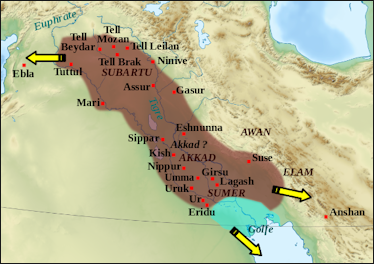
Akkadian PeriodBooks: Sumerian Dictionary of the University Museum of the University of Pennsylvania edited by Ake W. Sjoberg (University of Pennsylvania, 1984); The Sumerians, Their History, Culture and Character by Samuel Noah Kramer (University of Chicago Press, 1963); The Ancient Near East By William Hallo and William Kelly Simpson (Harcourt, Brace, Jovanovich, 1971); Ancient Near Eastern History and Culture by William H. Stiebing Jr. Experts and Sources:University of Pennsylvania Museum of Archaeology and Anthropology; John Russell, an art historian at the Massachusetts College of Art in Boston; Irene Winter, professor of art history at Harvard; McGuire Gibson of Oriental Institute of the University of Chicago; Jeremy Black, Oriental Institute at Oxford University; Piotr Michalowski, University of Michigan.
Websites and Resources: Ancient History Encyclopediaancient.eu.com/Mesopotamia ; Mesopotamia University of Chicago site mesopotamia.lib.uchicago.edu ; British Museum mesopotamia.co.uk ; Interent Ancient History Sourcebookfordham.edu/halsall/ancient ; Louvre louvre.fr/llv/oeuvres/detail_periode.jsp ; Metropolitan Museum of Art metmuseum.org/toah ; University of Pennsylvania Museum of Archaeology and Anthropology penn.museum/sites/iraq ; Oriental Institute of the University of Chicago uchicago.edu/museum/highlights/meso ; Iraq Museum Database oi.uchicago.edu/OI/IRAQ/dbfiles/Iraqdatabasehome ; Wikipedia article Wikipedia
Mesopotamian Geography
Strategically situated in the heart of the Near East and northeastern part of the Middle East, Mesopotamia was located south of Persia (Iran) and Anatolia (Turkey), east of ancient Egypt and the Levant (Lebanon, Israel, Jordan and Syria) and east of the Persian Gulf. Almost completely landlocked, its only outlet to sea is the Fao peninsula, a small chunk of land wedged between modern-day Iran and Kuwait, which opens to the Persian Gulf, which in turn opens into the Arabian Sea and the Indian Ocean.
Much of the agricultural land is in the fertile valleys and plains between the Tigris and Euphrates and their tributaries. Much of the agricultural land was irrigated. The forest are found predominantly in the mountains. Occupied by desert and alluvial plains, modern Iraq is the only country in the Middle East that has good supplies of water and oil. Most of the water comes Tigris and Euphrates. The majority of modern Iraqis live in cities in the fertile Tigris and Euphrates River valley between the Kuwait border and Baghdad.
Modern Iraq is divided into four principal regions: 1) an upper plain between the Tigris and Euphrates which stretches from north and west of Baghdad to the Turkish border and is regarded as the most fertile part of the country; 2) the lower plain between the Tigris and Euphrates, which extends from north and west of Baghdad to the Persian Gulf and embraces a large area of marshes, swamps and narrow waterways; 3) mountains in the north and northeast along the Turkish and Iranian borders; 4) and vast deserts which spread south and west of the Euphrates to the borders of Syria, Jordan and Saudi Arabia.
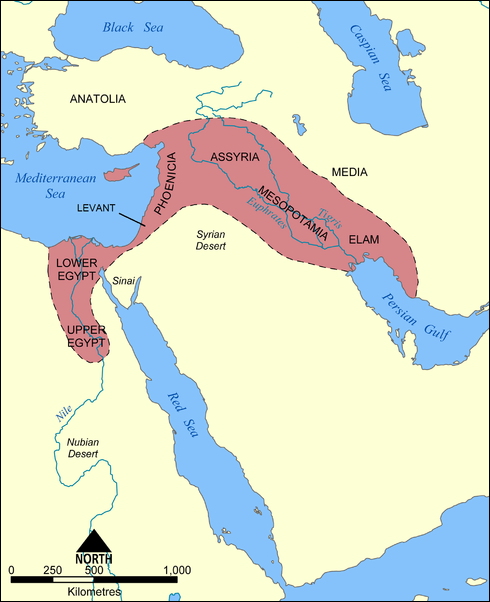
Deserts, semideserts and steppes cover about two thirds of modern Iraq. The southwestern and southern third of Iraq is covered by barren desert with virtually no plant life whatsoever. This region is occupied mostly by the Syrian and Arabian Deserts and has a only few oases. The semi deserts are not as dry as the deserts. These resemble the deserts of southern California. Plant life includes tamarisk shrubs, and biblical plants like of apple-of-Sodom and Christ-thorn tree.
Iraq's mountains are found primarily in the north and northeast along the borders of Turkey and Iran and to a lesser extent Syria. The Zagros mountains run along the Iranian border. Many of the mountains in Iraq are treeless but many have highlands and valleys with grass that has traditionally been utilized by nomadic herders and their animals. A number of rivers and streams flow out of the mountain. They water narrow green valleys in the foothills of the mountains..
Fertile Crescent, the Cradle of Civilization and the Levant
The Fertile Crescent is region of fertile irrigated land that stretched across Mesopotamia and reached down the Mediterranean coast and included present-day Iran, Syria, southeastern Turkey, Lebanon and Israel. The Fertile Crescent gave birth to the Judaism and Christianity and shaped Muslims-Arab culture. The Levant is the “land flowing with milk and honey." It usually referred to an area occupied by Israel, Lebanon, Jordan, western Syria and northern Arabia.
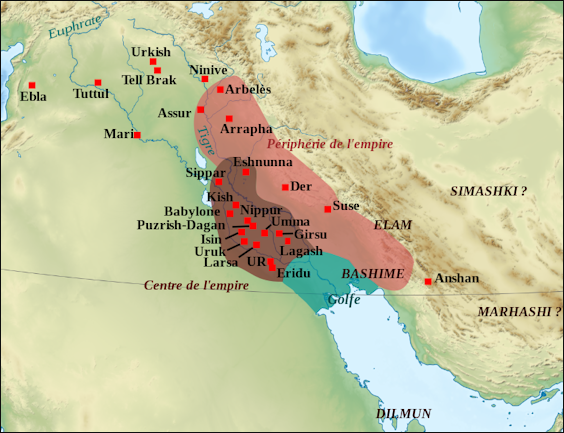
The fertile land around the Tigris and the Euphrates was the product of alluvial material and silt deposited by the rivers when they flooded in the spring. So fertile was the land it gave birth to story of the Garden of Eden. The fertile land was greatly coveted by the nomadic tribes that lived around it in Arabia, Turkey and Iran. Periodically they sweep down out of their homelands and try to claim parts it.
Mesopotamia is also referred to as the Cradle of Civilization. Most of the early Sumerian city-states in were near the mouth of the Euphrates in the southeastern Iraq and spread northward. The Babylonians were based near where the Tigris and Euphrates approach and diverge in central Iraq. The Assyrians were based around the Tigris in northern Iraq.
Tigris and Euphrates
The Tigris and Euphrates are two of the world's most famous rivers. The Tigris River is about 1,200 miles (1950 kilometers) long and originates in the mountains of southern Turkey and enters Iraq near the spot where Iraq, Turkey and Syria meet. The Euphrates is about 1,300 miles (2100 kilometers) long and originates in the mountains of central Turkey and flows a considerable distance through Turkey and Syria before it enters western Iraq.
The Tigris and Euphrates approach each other near Baghdad and roughly flow parallel to each other, separated by a distance of between 30 and 130 miles (50 to 210 kilometers), before they meet near Basra at Qurna, where they form the Shatt al-Arab, a waterway which flows 120 miles (195 kilometers) into the Persian Gulf and is navigable by large ships.
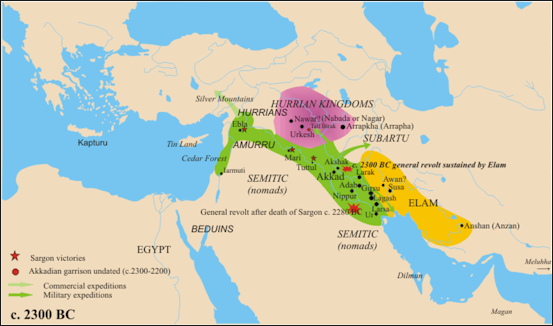
2300 B.C.
Silt from the Tigris and Euphrates rivers has built a long, fertile alluvial plain, and a large delta and vast marshes. The area around the rivers has been heavily irrigated since Mesopotamian times. In the north the rivers usually stay within their banks. In the south and east the rivers have traditionally flooded in the spring. Some barriers have been built to prevent this from happening near populated areas.
Snow melt in the mountains in Anatolia in the spring causes the Tigris and Euphrates to rise. The Tigris floods from March to May: the Euphrates, a little later. Some the floods are intense and the rivers overflow their banks and change course. Iraq also has some large lakes. Buhayrat ath Tharthar and Buhayrat ar Razazah are two large lakes about 50 miles from Baghdad. In southeast Iraq, along the Tigris and Euphrates and the Iranian border there is a large area of marshes.
The Sumerian cities of Ur, Nippur and Uruk and Babylon were built on the Euphrates. Bagdad (built long after Mesopotamia declined) and the Assyrian city of Ashur were built on the Tigris River.
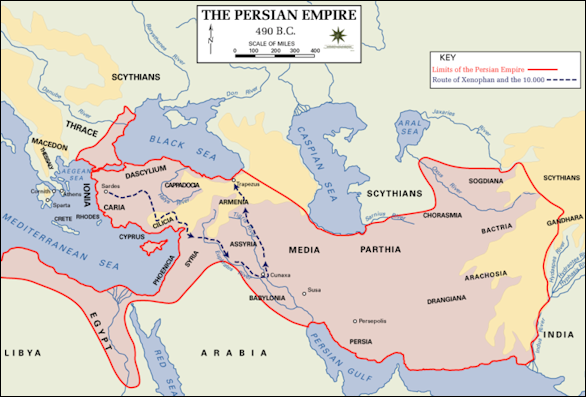
490 B.C.
Near East and Middle East
These days many people think of the Middle East as embracing the countries of Arab countries of Egypt, Lebanon, Syria, Jordan, Saudi Arabia, Kuwait, Bahrain, the United Arab Emirates, Qatar, Yemen, Oman, and Iraq. Some people also include Cyprus, Turkey, Israel and Iran, and a lesser degree Afghanistan, which are all not Arab. Sometimes Libya is included in the Middle East but is generally thought of being in North Africa. Sometimes Sudan and Mauritania are included but is generally thought of being in Africa.
The Near East was traditionally used to describe the region between the eastern shores of the Mediterranean to present-day Afghanistan. The Near East was commonly used to describe the region until the 1960s, when it started becoming more fashionable to use the term Middle East. The French and the U.S. State Department (2003) still use the term Near East. The United Nations used the term Near east, Middle East and West Asia.
Mesopotamian Sites in Iraq
Mesopotamian Sites in Iraq include: 1) Baghdad. Site of the National Museum of Iraq, which has the world's pre-eminent collection of Mesopotamian antiquities, including a 4,000-year-old silver harp from Ur and thousands of clay tablets. 2) The Arch at Ctesiphon. This hundred-foot arch on the outskirts of Baghdad is one of the tallest brick vaults in the world. A fragment of a 1,400-year-old royal palace, it was damaged during the gulf war. Scholars warn that its collapse is increasingly likely. [Source: Deborah Solomon, New York Times, January 05, 2003]
3) Nineveh. The third capital of Assyria. It is mentioned in the Bible as a city whose people live in sin. A whalebone hangs in the mosque on Nebi Yunis, said to be a relic from the adventures of Jonah and the whale. 4) Nimrud. Home of the Assyrian royal palace, whose walls cracked during the gulf war, and of the tombs of Assyrian queens and princesses, discovered in 1989 and widely considered the most significant tombs since King Tut's. 5) Samarra. Major Islamic site and religious center 70 miles north of Baghdad, very close to a main Iraqi chemical research complex and production plant. Home to a stunning ninth-century mosque and minaret that were hit by allied bombers in 1991.
6) Erbil. Ancient town, continuously inhabited for more than 5,000 years. It has a high ''tell,'' an archaeological marvel consisting of layered towns that were built one on top of the other over thousands of years. 7) Nippur. Major religious center of the south, well stocked with Sumerian and Babylonian temples. It is fairly isolated and thus less vulnerable to bombs than other towns. Ur) Supposedly the world's first city. Peaked around 3500 B.C. Ur is mentioned passingly in the Bible as the birthplace of the patriarch Abraham. Its fantastic temple, or ziggurat, was damaged by allied troops during the gulf war, which left four massive bomb craters in the ground and some 400 bullet holes in the walls of the city.
9) Basra Al-Qurna. Here, a gnarled old tree, supposedly Adam's, stands on the supposed Garden of Eden. 10) UrUk. Another Sumerian city. Some scholars say it is older than Ur, dating to at least 4000 B.C. Local Sumerians invented writing here in 3500 B.C. 11) Babylon. The city reached the height of its splendor during the reign of Hammurabi, around 1750 B.C., when he developed one of the great legal codes. Babylon is only six miles from Iraq's Hilla chemical arsenal.
Mesopotamian Advancements and Firsts
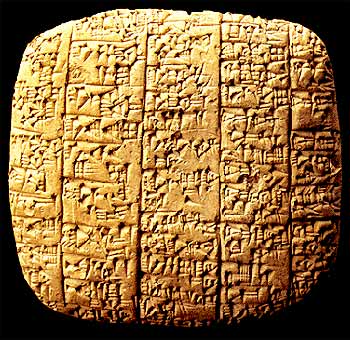
early writingWriting, irrigation agriculture, large scale trade, the upper class, the wheel, the centralized state, mathematics, astronomy, the sail, government bureaucracy, the 60-second minute and the 60-minute hour, large-scale beer production, written laws, state-sponsored warfare, imperialism, organized religion, the concept of kingship, monumental architecture, cities, organized religion, and the organized production of handcrafted goods were all developed and pioneered in Mesopotamia.
The jump from stone-age man (primitive man, early modern man or Cro-Magnon Man, whatever you want to call him) to modern man (or civilized man) is defined by some as taking place with the invention of agriculture around 10,000 to 8000 B.C., and by others with the development of writing around 3200 B.C. In Mesopotamia. Yet others say it took place with the invention of metals tools (beginning with copper ones) around 4500 B.C.
Mesopotamia also gave the world the zodiac, the 12-month year, the 360-degree circle, imperialism, state-sponsored warfare, urban living, labor specialization, political empires, the potter's wheel, sailboats, wheeled vehicles, kiln-fired bricks, large scale beer production, maps dating back to 2300 B.C., and the first written code of law.
Stone Age Mesopotamia
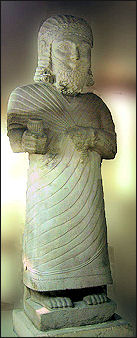
ArslantepeNemrik, Qermez dere and M’lefaat are among the oldest villages in the world. Located in northern Iraq and dated to around 8000 B.C., they feature evidence of early agriculture and animal domestication.
See First Villages, Early Agriculture
Around 10,000 years ago, people that lived in what is now Turkey and northern Iraq began migrating southward. They hunted deer, gazelles, onagers and wild sheep and goats, gathered wild grasses such as wild barely and wheat and were beginning to herd sheep and goats, build simple dwellings and raised crops.
These people eventually settled in the valleys between the Tigris and Euphrates Rivers. Little is known about them. At Mureybit, a site on the banks of the Euphrates, seeds from an uplands area---where the plants from the seeds grow naturally--- were found and dated to 11,500 years ago. An abundance of seeds from plants that grew elsewhere found near human sites is offered as evidence of agriculture.
By 6000 B.C., the Tigris and Euphrates river basins were inhabited by herdsmen and farmers who settled in towns and villages and practiced stock breeding, grain cultivation and irrigation. These people evolved into the agriculturally-based prehistoric al-Ubaid culture, which appeared 5000 B.C. in Mesopotamia.
First Mesopotamian Civilizations
After agriculture and herding were invented, population expanded and people were freed from foraging for food and were able to develop complex technologies and social organizations that gave them an edge over the people who didn't have these advances.
Around 5000 B.C., early irrigation canals were built on a steppe east of Mesopotamia (there is also very old evidence of irrigation at other places including 9,500-year-old Catalhoyuk in Turkey). The canals brought water to new fields. Around 3500 B.C. irrigation systems created food surpluses that generated a labor surplus---the widely accepted theory goes---that enabled the construction of the world's first cities with monumental architecture, division of labor and stratification of society.
The first irrigated crops in the American date back to 5,400 years ago or perhaps as long as 6,700 years ago. The remains of ancient irrigation ditches dated to those periods have been found in the Zana Valley in the Andean foothills of Peru, 65 kilometers from the ocean and 300 mile north of Lima.
The first civilizations of Mesopotamia were made possible by grain surpluses produced by irrigation. This development freed the population from the toils of farm labor, and gave them the time to establish organizations and produce writing.

ziggurat of Ur
First Mesopotamian Cities
Eridu, where artifacts have been found that date back to 5000 B.C., is regarded as Mesopotamia's oldest city. In the Eridu area a cluster Mesopotamian settlements were established in ancient Sumer, an area with fertile soil in present-day southern Iraq around 3500 B.C. These settlement grew into the city states of Ur (home of Abraham and the Chaldees in the Bible), Uruk (the Biblical city of Erech), Lagash, Nippur, Umma, Sippar, Larsa, Kish, Adab, and Isin.
Life in the earliest Mesopotamia cities was organized around temples and priestly bureaucracies. The surrounding plains were watered by vast irrigation systems and worked with traction plows. Economies were run by central authority. The people developed sailboats, wheeled vehicles, potters wheels and kilns. They smelted and tempered copper from 4000 B.C. and bronze not long afterwards. Ores and precious metals were obtained through long distance caravan trade.
Ancient civilization developed at the sites in southern Iraq and spread northward and westward. Empires in Mesopotamia violently appeared and disappeared. Unprotected by natural barriers and vulnerable to drought, Mesopotamia endured frequent invasions and famines.
Population of Mesopotamia
One of the most astonishing revelations of the tablets recovered from Ebla was how densely populated Mesopotamia, Syria and the Middle east were. More than 5,000 geographical names are mentioned, including names mentioned in the bible. Italian archaeologist Giovanni Pettinato told National Geographic, “We encounter a swarm of small states even in the immediate vicinity of Ebla...The enormous number of cities and villages presents an entirely new picture of the urbanization of Syria and Palestine in the third millennium B.C.
Large cities in the Near East in the third millennium B.C. had only around 20,000 or 30,000 people.
Mesopotamia vs. Egypt

Egyptian Hieroglyphs The civilizations of Egypt and Mesopotamia existed pretty much at the same time. Sumer in Mesopotamia is often credited with being the oldest civilization in the world because it came up with a writing system first. Although the two empires were only about 600 miles apart they developed as empires pretty much on their own. This is partly explained by the fact that there was a big desert between them. [Source: H.W. Janson," History of Art Prentice Hall, Englewood Cliffs, N.J."
For much of its early history Mesopotamia was occupied by rival kingdoms. Few of them were able to exert much influence beyond the borders of their realm. Sumer were not a unified kingdom.. Rather it was like ancient Greece, a composite of often feuding city-states. Babylon was a kingdom that did not control a very large area and did not rule terribly long. With the exception of the brief and unstable Akkadian empire around 2300 B.C. there was no kingdom that ruled over what would qualify as an empire until the Assyrians arrived on the scene in the 9th century B.C.
Another difference between the two cultures is that, at a given time, Egypt flourished under the leadership of one ruler and was relatively peaceful while Mesopotamia was often divided into several kingdoms and city-states and was racked by wars. This too is partly explained by geography. Mesopotamian kingdoms were spread out between two rivers and its many tributaries, and could be easily attacked from any direction, while ancient Egypt was located primarily within one river valley and was removed from the outside world by deserts. Attacks usually only came from the northeast---and to a lesser extent in the south---which meant defenses could be concentrated there. The fact that Mesopotamia was composed of many different kingdoms and city-states that rose, dominated, declined and battled each other also explains why it was never produced a single unified tradition of culture like Egypt. [Janson, Op. Cit]
See First Writing
Mesopotamia and the Bible

Middle Ages view of the
Babylonian siege of Jerusalem The first 11 chapters of Genesis are largely set in Mesopotamia. Eden is a Sumerian word meaning “steppe," and was a district in Sumer. The Tower of Babel was in Babylon. The Hanging Gardens may have inspired the story of the Garden of Eden. According to Genesis Abraham and Cain and Abel and numerous other Biblical figures were born in Mesopotamia and the first cities founded after the flood were Babel (Babylon), Erech (Uruk), and Accad (Akkad) there.
Cuneiform tablets found in Ebla mention the cities of Sodom and Gomorrah and contain the name of David. They also mention Ab-ra-mu (Abraham), E-sa-um (Esau) and Sa-u-lum (Saul) as well as a knight named Ebrium who ruled around 2300 B.C. and bears an uncanny resemblance to Eber from the Book of Genesis who was the great-great grandson of Noah and the great-great-great-great grandfather of Abraham. Some scholars suggest that Biblical reference are overstated because the divine name yahweh (Jehovah) is not mentioned once in the tablets.
The Babylonians also had myths also that bore of striking resemblance to the creation of Eve from Adam's rib and the story of Noah's Ark. See Literature.
Abraham was born under the name Abram in the Sumer city of Ur in Mesopotamia (in present day Iraq). According to Genesis, Abraham was the great, great, great, great, great, great, great, great grandson of Noah and was married to Sarah.Genesis 11:17-28, reads “Terah Begot Abram, Nahor, and Haran, and Haran begot Lot. And Haran died in the lifetime of Terah his Father in the land of his birth, Ur of Chaldees."
Rivals To Mesopotamia's Claim of the First Civilization
Tell Hamoukar is an interesting site, dated to 3500 B.C., in eastern Syria near the border of Iraq and Turkey. With a central city covering 16 hectares, it is as highly developed as sites in southern Iraq such as Uruk and Nippur and seems to debunk the theories that ancient civilization developed in southern Iraq and spread northward and westward. Instead Tell Hamoukar is offered as proof that several advanced ancient civilizations developed simultaneously in different parts of the Middle East. [Source: Natural History magazine, Clemens Reichel of the Oriental Institute of Chicago]
Excavations indicate that Tell Hamoukar was first inhabited around 4000 B.C. perhaps as early as 4500 B.C. By around 3700 B.C. is covered at least 13 hectares and displayed signs of an advanced civilization: a 2.5-meter-high, 3.4 -meter-wide defensive wall, large scale bread making and meat cooking, a wide array of cylinder seals, presumably used to mark goods. Many seals were used to secure baskets and other containers of commodities.
The simplest seals had only simple markings. More elaborate ones had kissing bears, ducks and a leopard with 13 spots. Scholars believed that more elaborate seals were used by people of high status and indicate a hierarchically-ordered society. But as advanced as Tell Hamoukar and other places in the area were they are not regarded as advanced as those in southern Iraq, where writing developed.
Tell Hamoukar contains a 500-acre site with buildings with huge ovens, which offer evidence that people were making food for other people. The city seems to have been a manufacturing center for tools and blades that utilized obsidian supplies further north and supplied the tools throughout Mesopotamia to the south. Other sites being excavated in northern Syria include Tell Brak and Habuba Kabira, both of which appear ro be much larger than previously thought.
A team led by Clemens Reichel of the Oriental Institute of Chicago and Syrian Department of Antiquities have been excavating Tell Hamoukar since 1999.. Guillermo Algaze of the University of California, San Diego is an archaeologist that specialize in north-south relations in Mesopotamia.
Image Sources: Wikimedia Commons
Text Sources: Mostly from National Geographic, Smithsonian magazine and New York Times articles, especially Merle Severy, National Geographic, May 1991 and Marion Steinmann, Smithsonian, December 1988. Also from the Washington Post, Los Angeles Times, Smithsonian magazine, Discover magazine, Times of London, Natural History magazine, Archaeology magazine, The New Yorker, Time, Newsweek, Wikipedia, Reuters, AP, AFP, Lonely Planet Guides, World Religions edited by Geoffrey Parrinder (Facts on File Publications, New York); History of Warfare by John Keegan (Vintage Books); History of Art by H.W. Janson Prentice Hall, Englewood Cliffs, N.J.), Compton's Encyclopedia and various books and other publications.
No comments:
Post a Comment